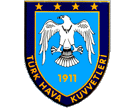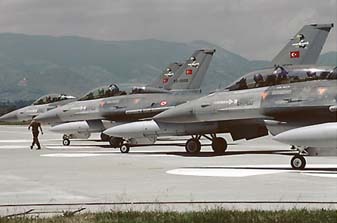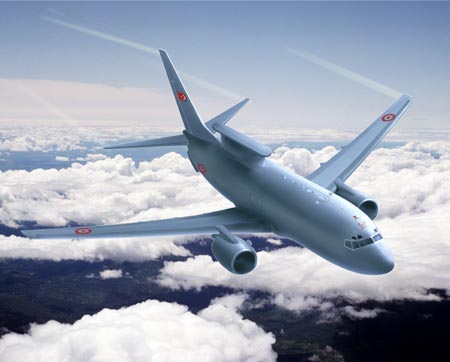

| The Turkish Air Force (TuAF, Turk Hava Kuvvetleri) is one
of Europe's oldest air forces, with it's roots going back as far as 1911
and has operated more than 180 different aircraft types. Originally under
command of the Army, the TuAF became independent on 31 January 1944,
operating a mix of fighter types. Turkey joined NATO in 1952, becoming the
most easterly NATO member. The TuAF entered the jet era with the T-33A in
1951, followed by large numbers of F-84F Thunderstreaks, F-100 Super
Sabres, F-102 Delta Daggers and F-104 Starfighters. Not least because of
the shared borders with the former Soviet Union, Syria , Iraq and lifetime
enemy Greece, Turkey's Air Force has always been substantial. Historically
among the most active buyers of weapons in the world (ranked third on the
list of major recipients of weapons between 1994 and 1998), Turkey is
readying to begin implementing one of the most ambitious military
modernization programs in the post-Cold War era.
Introduced in 1996, the
Turkish military's $150 billion program aims at a wholesale modernization
of the armed forces over a period of 25 to 30 years. Turkey, together with
Greece, stand out among their NATO allies for their inability to reduce
their military spending after the collapse of the Warsaw Pact and the
Soviet Union. While the average size of the defense expenditures relative
to the GDP fell to 2.7 percent among NATO countries, it remains at Cold
War-high level of 4.4 percent in Turkey
(4.8 percent in Greece). |
| Turkish officials maintain that high defense
spending and a modernization program are required to guarantee the
security of the country. "Turkey...cannot receive her share of the
'peace dividend' despite the fact that she is in dire need of it,"
wrote former Undersecretary of Turkish Ministry of Foreign Affairs, Dr.
Sukru Elekdag, in 1996. He added, "The threats facing Turkey are so
diverse and acute that Turkey can only maintain peace by adhering to the
old adage, 'Those who want peace must be prepared for war.'' A 1998 White
Paper prepared by Turkey's Ministry of Defense lists Iran, Syria, and
Greece as primary external threats. |
 |
| While relations with Iran
remain constant, Turkey's ties with the latter two countries only worsened
since the document's publication. Greece and Turkey narrowly averted a
possible confrontation in December 1998 over the deployment of
Russian-made S-300 missiles on the island of Cyprus.
Turkey has joined the system development and demonstration phase of the
Lockheed Martin F-35 Joint Strike Fighter, at a cost of $175 million. It
will invest another $75 million if the government decides the country will
participate in the industrial package of the programme. The Deal which
makes Turkey a level 3 partner in the programme was signed on July 11
2002. A requirement exists for 150 F-35s to replace F-4Es and F-16Cs from
2013. Turkey and Israel are building on their military (friendship)
co-operation with a number of joint projects like the upgrading of 54
Turkish F-4E Phantoms which will involve a avionics and structural
upgrade, the upgraded Phantoms will be known as F-4E 2020 Terminator.
|
 |
Another joint
project is the upgrading of 48 Turkish F-5 Freedom which will see them
undergo structural improvements with work shared by TAI (Tukish Aerospace
Industries) and IAI (Israeli Aerospace Industries). The first F-5 made its
first post-upgrade flight on April 17, 2001. The contract for the Boeing 737-700 Airborne Early Warning &
Control aircraft was signed on June 4, 2002. The contract covers the firm
commitment to four 737s, with a further two options and is worth $1.1
Billion. The first aircraft is expected to be delivered at the end of 2005
after being completed at Boeing's facilities : the other three firm order
aircraft will be fitted out in Turkey by TAI. |
|
Under the Phoenix II programme, 30 AS 532 Cougars are being
manufactured by Turkish Aerospace Industries. A total of 20 are destined
for the Air Force, 15 of these had been delivered by July 2002. The last
Phoenix II Cougar is scheduled for delivery on January 31, 2003. The
Cougars will replace UH-1Hs in the Turkish Air Force. The Turkish Air Force expects to receive 10 Airbus Military Co. A400Ms,
down from 20 planned , with a workshare of 6.7% being allocated to TAI from the
order.
A new training aircraft is sought to take pilots from the initial
stages of training and prepare them for the T-38 Talon advanced trainers.
The Pilotus PC-9 and derived Raytheon T-6 Texan II, Embrear Tucano and KAI
KT-1 are all under consideration but no contract has yet to be signed. On March 20, 2002, senior Turkish military officials announced that the
tender for a heavy lift helicopter will be reopened in 2003. The
competition is expected to be between the Boeing CH-47 Chinook and the
Sikorsky CH-53. The requirement is for 20 helicopters, and is expected to
cost $250 million. A previous tender was won by an improved version of the
CH-53E, but the eight on order were cancelled in 2001 due to budget
constraints.
|
Aircraft of the Turkish Air Force :
Fighter/Attack :
- Joint Strike Fighter (JSF)
 |
On July 11 2002, Turkey became the seventh international
partner to sign up for the F-35 Joint Strike Fighter program, joining the
United Kingdom, Italy, the Netherlands, Canada, Denmark and Norway.
Australia also has announced its intention to participate. Turkey and the
other countries participating in the F-35’s decade-long System
Development and Demonstration (SDD) phase will have the opportunity to
develop and supply parts and systems, influence the aircraft's design and
place representatives in the government's JSF Program Office.
Over the life of the program's SDD phase, Turkey will contribute
approximately $175 million to the F-35's development. Turkish industry
will benefit through 'best value' contracting with the prime contractors
Lockheed Martin, Pratt & Whitney or General Electric engines along
with many sub-vendors. Industry-to-industry discussions are taking place
now and will result in a long-term relationship with United States and
partner industries. Turkey has an active engine production facility in
partnership with General Electric that could play a substantial role in
Turkey's industrial and post-production involvement in the JSF.
It
will invest another $75 million if the government decides the country will
participate in the industrial package of the programme. A requirement exists for 150 F-35s to replace F-4Es and F-16Cs from
2013. |
- F-16 C/D Fighting Falcon



|
 |
Peace Onyx I
Under the Peace Onyx I program, realized between the years 1987-1995,
Turkish Aerospace Industries manufactured and delivered a total of 152 F-16C/D
(132 F-16Cs and 24 F-16Ds) aircraft in Block 30 and 40 configurations at TAI facilities
in Akinci to the Turkish Air Force (TuAF). The program covers 160 F-16s, eight of which were produced at the then General Dynamics, Fort Worth facilities and delivered to
TuAF. Under the terms of Peace Onyx I, TAI is not allowed to
sell its aircraft to any air force, including the THK. Consequently,
F-16s built at Murted have to be first delivered to the USAF, which
then turns them over to the THK. In practice, each locally-built F-16
makes a flight to NAS Sigonella (or any other US base close to Turkey)
where it performs a touch-and-go (obligatory; the aircraft has to
touch US soil) and then flies back to Turkey. The Turk Hava Kuvvetleri
(THK, or Turkish Air Force) received its first two F-16s (both
Lockheed-built Block 30 F-16Cs as assembly kits in March of 1987, and
Turkey officially received its first F-16D in a ceremony at Fort Worth
in July of 1987. The first Turkish F-16C/Ds arrived at Akinci AB in
October of 1987, followed by the first flight of a Turkish-built F-16C
on October 20, 1987. Starting with the 44th aircraft, all Turkish Air
Force F-16s from the first batch were manufactured to Block 40
standards. The first 43 F-16s were Block 30 versions. |
 |
Peace Onyx II:
Within the framework of the follow-on program “Peace Onyx II,” TAI produced an additional 80 F-16C/D aircraft in Block 50 configuration
(two batches of 40 Block 50 F-16C/Ds) during the 1995-1999 period for
TuAF. The Block 50 machines will be equipped with the APG-68(V5) radar
and the ability to carry and launch the AGM-88 HARM anti-radiation
missile. The introduction of the Block 50 gives the THK F-16 force
true SEAD capabilities. |
Thomson-CSF, in partnership with Aselsan, the
Turkish prime contractor, announces the signature of a contract to provide
the Turkish Air Force with a complete Electronic Warfare system to equip
F-16s.The contract includes a high technology and industrial transfer from
Thomson-CSF to Aselsan. Thomson-CSF is responsible mainly for the design
and production of the first units to be delivered. TAI realized structural modification (FALCON-UP) on the Turkish Air Forces’ (TuAF) pre-Block 50 F-16C/Ds between the years of 1993-1999. |
- F-4E /RF-4E Phantom II (F-4E 2020 Terminator)


|
The Turkish Air Force has received about 197 F-4Es and
40 RF-Es in eight batches from 1973 to 1994, including
40 aircraft which had been delivered as a return favor for the Turkish
support of the UN Forces during the Gulf war in 1991.To augment the few
surviving RF-4Es of the first batch of 1973, the TuAF received 32
operational former German Air Force RF-4Es. The TuAF has planned an
upgrade for part of it's F-4 Fleet with a structural upgrade and the
installation of the improved avionics system, which will be called the
F-4E 2020 Terminator. The full upgrade program consists of 54 F-4
aircraft, of which 26 will be completed at IAI's Lahav Division and 28
aircraft will undergo modernization by the TUAF at Eskisehir Air Force
Base in Turkey. IAI, the main contractor, and Elbit, a major
subcontractor, together with other Israeli and Turkish industries, will
supply a modernization kit to the TUAF. The Turkish Ministry of National
Defense awarded the F-4 upgrade contract to IAI in August 1995. The total
value of the program is $632 million. The upgrade involves a structural
and avionics upgrade, the first of 28 to be upgraded at Eskisehar -known
as TAMP (Turkish Aircraft Modernisation Phase) aircraft to differentiate
them from the Israeli upgrade Phantoms was redelivered on July 3rd 2002.
|
- F-5A/B / NF-5A/B / F-5 2000


|
Today all Turkish F-5s are based at Konya, where 133 Filo operates a
large mix of RF-5As, F-5A/Bs and NF-5A/Bs for combat training, while 132
Filo loans F-5s for tactical weapon training and instructor training. Also
based at at Konya is 134 Filo 'Turk Yildizlari' (Turkish Stars)
demonstration team operating NF-5A/Bs. Turkish F-5s have come from a wide
variety of sources including Netherlands, Norway, Taiwan and the United
States.The F-5/2000 modernisation programme aims to upgrade 48
F-5A/B and NF-A/B aircraft with new avionics to improve their navigation
and operations capability.
The avionics modernisation part of the contract was signed in 1998, IAI
having design leadership in the IAI/Elbit and Singapore Technologies
Aerospace consortium. The avionics modernisation, design and
implementation on the first four prototypes was carried out by IAI in
Turkey at the 1st ASMC (Air Supply Maintenance Center) command facilities
at Eskisehir. The remaining 44 aircraft will be upgraded by the 1.ASMC
command. At the moment, 20 F-5s are in the process of being upgraded and
the project will be completed in 2006. Under the contract, 6 NF-5B, 8
F-5B, 14 NF-5A and 20 F-5As will go through the modernisation
process.
The F-5/2000 modernisation project covers two areas - Structural
Upgrade and Avionics Modernisation. The upgraded F-5s are based at the 3rd
Main Jet Base command at Konya, where 133 Filo Command operates the new
F-5s and is responsible for the Combat Readiness of new graduates selected
for duty on the F-16. Modernised F-5s will be used mainly on the F-16
lead-in-training programme. In addition modernised F-5s have the
capability to carry AIM-9 Sidewinder missiles on the wing tips. The latest milestone achievement took place in Turkey on April
17, 2001, when the first flight, of an F-5 prototype that was upgraded in
Turkey, was successfully completed.
|
Transport :
- C-130 B/E Hercules


|
Turkey received it's first Hercules, under the US
Military Assistance Program, in the shape of four C-130Es delivered in 1964.
One of the original "Es" was written off in 1968. Two more
C-130Es were delivered in 1971 and a single C-130H in 1987. Turkey
acquired six former USAF C-130Bs in 1991. They are flown by the Alev
(Flame) No. 222 Squadron at Erkilet/Kayseri.
Elbit Systems Ltd and Israel Aircraft Industries Ltd have been short
listed to upgrade the Turkish C-130 fleet. The C-130 avionics upgrade
program, involving electronics work and components is expected to cost
Turkey around $25 million. Work will be done at a Turkish Air Force
aircraft maintenance base in Kayseri, Central Anatolia.
|
- C-160D Transall
 |
Since 1971, 221 Filo at Erkilet has operated 19
ex-German Air Force C.160Ds. The C-160 Transall aircraft are twin
turboprop transporters in service with the air forces of France, Germany
and Turkey. The aircraft is a cantilever high-wing monoplane and is
configured for transportation, paratroop drop, electronic surveillance,
airborne communications relay and medical evacuation.
The main cabin can be fitted to carry 93 troops or up to 68 fully
equipped paratroops. For medical evacuation, the cabin can accommodate 62
stretcher patients. In the cargo transporter role, the aircraft can carry
a maximum payload of 16,000kg, including armoured vehicles, tanks and
palletised or unpalletised loads.Loads up to 8,000kg can be air-dropped.
The aircraft can carry out low-level altitude drops at altitudes between
10 and 30ft, and touch-and-go drops in which the aircraft briefly touches
the runway without landing. |
- CN-235
 |
Special mention should also be made of the fleet of 52
CN-235 planes in service with the Turkish Air Force and manufactured by
TAI, not just because of its size - since it is the World’s biggest
fleet of CN-235 aircraft - but also because of its very high degree of
readiness which exceeds 90%. This translates into an enormous operational
capacity in the diverse missions that are being undertaken, including
Logistical and Tactical Transport from the bases at Etimesgut, Diyarbakir,
Eskiseir and Izmir.
TAI was responsible for the manufacturing of 50 of the 52 CN-235
produced for the Turkish Air Force at its Akinci (Ankara) production
centre between 1991-1998. Production of the CN-235 continues at TAI for
smaller numbers of surveillance and maritime patrol variants for the
Turkish Navy and coast guard respectively.
|
- A400M
 |
The A400M (formerly known as the Future Large Aircraft) is a
military transporter designed to meet the requirements of the air forces
of Belgium, France, Germany, Italy, Spain, Turkey and the United Kingdom.
Italy subsequently withdrew from the programme. A European Staff Target
was drawn up in 1993 together with a Memorandum of Understanding signed by
the governments of seven nations. In December 2001, a formal contract of
procurement was signed between Airbus and OCCAR, the European procurements
agency for 196 aircraft: Belgium 7, France 50, Germany 73, Luxembourg 1,
Portugal 3, Spain 27, Turkey 10 and the UK 25 aircraft. The first aircraft
is scheduled to fly in 2006 with entry into service in 2008.
The Turkish Air Force expects to receive 10 Airbus Military Co. A400Ms,
down from 20 planned , with a workshare of 6.7% being allocated to TAI from the
order. |
Tankers :
- KC-135R Stratotanker
 |
The first Turkish Air Force KC-135R was officially handed
over in October 1997, they belong to the tanker Filo temporarily based at
Incirlik which will eventually operate seven Stratotankers. The United States was
leasing two KC-135s to Turkey prior to the sale. The two-year agreement
also called for U.S. Air Force personnel to train their Turkish
counterparts. As part of the arrangement, a technical assistance team from
the US helped train Turkish personnel who will maintain and
operate the new fleet. The two leased aircraft were returned to the United
States Dec. 10, following the expiration of the lease.
All seven Turkish KC-135Rs are in the process of receiving the Pacer
CRAG (Compass, Radar and Global Positioning System) upgrade. In addition
to the Pacer CRAG modification, the aircraft will receive new and more
sophisticated booms which will require less maintenance, have a longer
service life and comprise of fewer pieces. Pacer CRAG is an avionics
upgrade. The upgraded avionics include cockpit enhancements with the
Collins FMS-800 integrated flight management system, Collins FDS-255
liquid crystal flat-panel multifunction flight display, and the Collins
WXR-700X forward-looking predictive wind shear weather radar. The flight
management system is integrated with a traffic alert and collision
avoidance system (TCAS) and an enhanced ground proximity warning system (EGPWS).
Most of the instruments are supplied by Rockwell Collins, with Raytheon
responsible for the Turkish KC-135R Pacer CRAG modification programme.
Aside from the Pacer CRAG upgrade, plans are being produced for
overhauling the seven KC-135Rs at the 2nd Air Supply Maintenance Centre
Command (2nd ASMCC) stationed at Kayseri.
|
AEW&C Systems :
- Boeing 737 AEW&C
 |
The Undersecretariat for Defense Industries
of the Republic of Turkey has signed a $1 billion-plus contract on June
4th 2002, with Boeing for the design and development of a state-of-the-art
737 Airborne Early Warning & Control (AEW&C) system also being
developed for Australia. The international Boeing-led team
responsible for the program includes Northrop Grumman Electronic Systems
and several major Turkish companies including TAI and Havelsan. The
contract calls for four 737 AEW&C aircraft plus a ground support
segment for mission crew training, mission support and system maintenance
support. The U.S State Department and Congress must now approve the
contract, which could take several months. Following that, efforts will
focus on the design for the radar, communications systems and the aircraft
subsystem. The Boeing AEW&C system combines the
high-performance 737-700 increased gross weight aircraft with Northrop
Grumman's Multi-role Electronically Scanned Array (MESA) radar with
integrated identification friend or foe capabilities. The Turkey 737 AEW&C
airborne system contains a mission computing subsystem featuring a
flexible, open-system architecture, and includes a Turkish-built
electronic support measures subsystem and an extensive communications
suite. Boeing will complete the first aircraft, whilst TAI will
modify the other three at it's facilities in Turkey. Turkey will also
supply and integrate the electronic support measures systems and
communications equipment. Major maintenance will be undertaken by one of
Turkish Airlines operating the 737-700 or -800, on which the AEW&C
version is based. The first aircraft could be delivered to the Turkish Air
Force 42-48 months after the contract is iniated. |
Helicopters :
- AS-532AL/UL Cougar
 |
In 1997, the EuroTAI consortium was formed between
Eurocopter and TAI to co-produce the AS 532 for Turkey. Under the Phoenix
II programme, 30 AS 532 Cougars are being manufactured by Turkish
Aerospace Industries. A total of 20 are destined for the Turkish Air
Force, 15 of these had been delivered by July 2002. The Last Pheonix II
Cougar is scheduled for delivery on January 31, 2003. The Turkish Air
Force Cougars have been built in two distinct types. Six AS 532AL Cougar
Mk 1 CSAR (Combat Search and Rescue) versions have been delivered, and 14 AS 532UL Cougar Mk 1 SAR variants. The Cougar will replace the
UH-1Hs in the Turkish Air Force.
The AS 532AL/UL is the first French helicopter to the enter service
within the TuAF. The CSAR version includes GIAT Industries NC621 machine
gun pods (20mm M621 gun), rocket pods, Aselsan-built AselFLIR-200, Bendix
1500B search radar, NVG suitable cockpit lightning and INS/GPS.
|
Sources :
Visit the Site's Forum ''World's
Armed Forces Forum''
| The pictures and text displayed
on this site have been found by me on the Internet or given to me by
visitors. If these are copyrighted, let me
know and I will remove them.
|
|